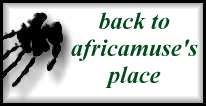POWER RELATIONS IN THE BIOMEDICALISED BIRTH PROCESS:
A CAPE TOWN CASE STUDY
by
S. J. Smith
africamuse@yahoo.com
(continued from Part One)
THE DISTORTION OF POWER AND THE MANIPULATION OF KNOWLEDGE
Turner (1987:47) argues that differences in knowledge are closely related to differences in social power in the doctor-patient relationship. The same can be said of the relationship between nurse-midwives and childbearing women. It should be noted that a number of authors (for example, see Chalmers 1990:75 and Rothman 1985:121) make the point that a birth attended by a midwife, rather than an obstetrician, or in a home-like setting, rather than a clinical one, does not necessarily put the labouring woman in control of the birth process.
During the delivery I observed, Sister Lewis was effectively in control of the labouring mother, Sara. Sister Lewis told Sara to push when she felt contractions. Later, Sara was asked whether she felt the pain yet, and her answer, "not yet,"* was accepted. This was the only time her intimate knowledge about the way in which her own body was reacting to the labour was either elicited or acknowledged. Subsequently, Sara was required to push when instructed to do so. She was, apparently, expected to ignore her own awareness of the sensations she was experiencing during the labour. At one stage, for instance, the nurse-midwife told her to push as if she was going to defecate, and when Sara replied that she felt no urge, she was brusquely instructed "Don't talk, just push!"* Sara obeyed.
In non-biomedical deliveries, the birthing woman is often an important source of knowledge to birth attendants, who rely on the information she gives in order to assess which actions should be taken (for example, see Jordan, 1990:107). The use of high-technology in clinical settings has, by contrast, turned knowledge about childbirth into a specialisation (Jordan, 1990). The result of this is that birthing women have become dependent on the possessors of this specialised knowledge.
The harsh treatment received by Sara during the delivery of her daughter was made possible largely because of her dependence on the knowledge of the biomedical staff. This is the basis on which Sara, herself, accepted this treatment as legitimate. Throughout the delivery, Sister Lewis used Sara's ignorance and unfamiliarity with medical knowledge and technology to her own advantage. Sister Lewis told Sara that she had to push and, in order to keep her pushing, said that she would prove to her that the baby's heart rate was too slow. She used a foetal monitor to amplify the heart beat and, although she had indicated a possible problem to Sara, neither she nor the other nurses seemed concerned. Both mother and nurse-midwife could hear the heart beat, but only the latter had the biomedical knowledge and technical skills to understand what it meant. Later, Sara was told that her child would be smothered if she did not push her out quickly, although, again, there was no indication that this was the case. Sister Lewis was thus able to manipulate the mother, through fear, into complying with her wishes.
This was not an isolated incident. Amanda said that she had, in the course of her obstetrical training, often heard nurse-midwives say similar things to mothers. She quoted, as an example, one nursing sister who told a labouring woman: "If you don't push the baby out now, it will have brain damage, it will have to go to Eros 8". Such statements are not necessarily correct, but confirm the perception of the mother that she is utterly dependent on those managing her own labour and delivery, that the nurse-midwife's biomedical knowledge is superior to her own sensations, and that instructions must be obeyed, quite literally, on pain of death.
The perception of biomedical practitioners as possessors of knowledge and childbearing women as non-possessors is not a true reflection of reality (for example, see Jordan, 1990). The birthing woman possesses valuable knowledge about the way her body feels, the intensity and length of her contractions, her own urges to push, and her unique awareness of which birthing position will work best for her. As Oakley (1981:203) states:
"For mothers, conversely, childbearing is more likely to be seen as ... a process that women as the possessors of wombs know something about."
Yet many mothers accept a biomedical management of the birth process which minimises the importance of their knowledge. To apply Lewis' and Salo's discussion of women's acceptance of the violation of their rights in another area of reproduction, i.e. birth control, they are:
"reluctant to challenge the authoritative discourse of medical technology with their own self-knowledge" (Lewis and Salo, 1993:61).
On the day after the delivery, I asked Sara how she felt about the way she had been treated by the nursing staff. She replied that it was "hard,"* but that "it is necessary that they be hard"* in order that the woman can be "encouraged"*, thus shortening the labour. This view was not supported by any other source consulted, biomedical or otherwise, with the exception of Sister Lewis' remark after the birth that some women make the delivery difficult for themselves, and so must be made to push. Amanda, in fact, mentioned that special attention given to a birthing woman seemed to make her labour easier. In addition, it begs the question of whether or not a shortened labour is, indeed, desirable, why, and for whom. Hurried labours may, for example, increase the likelihood of the perineum tearing, or of an episiotomy and subsequent stitching becoming necessary (for example, see Gottlieb, 1995:13), but may nevertheless be seen as desirable by tired nurse-midwives in an understaffed MOU.
Sara, however, accepted the way in which she was treated as legitimate. Lewis and Salo (1993:60) argue that:
"syndromes of deference and awe towards technological and scientific knowledge lead to a belief that medical information is beyond reproach or question."
BIOMEDICAL PRACTITIONERS AS MORALISERS
According to Zola (1972), biomedicine can play a moralising and sanctioning role in society, thus allowing medical practitioners influence beyond their technical functions and skills. Biomedicine, and its individual practitioners, can exert a great deal of control in their choice of whom to treat, whom to treat better, what to treat, and what to use as treatment.
If the mothers interviewed had been private patients, for example, they would almost certainly have been treated differently. Although their treatment would still have been administered according to biomedical principles and techniques, commercial considerations, as well as a higher ratio of staff to labouring women, more beds and a longer lying-in period, would have improved the quality of the service provided. As it was, the feelings of the women at the MOU were seldom taken into account.
Privacy, for example, is not prioritised at the MOUs. There were two beds in the delivery ward at the MOU, and while Sara was alone when she gave birth, this is obviously not always the case. At another MOU, Mpho lay in the delivery ward while another woman's baby was delivered shortly before she, herself, gave birth. Witnessing the other woman's pain had greatly increased her own feelings of fear.
Zola (1972:489) uses the example of different classes receiving unequal treatment. The model is equally applicable to individual practitioners who, because of their positions of power within the clinical and consequently the social setting, are able to choose how to treat mothers according to their own biases and moral values. Prejudice concerning single parenthood is a prime example.
According to University of Cape Town obstetrics lecture notes: "...women who have, in addition to the midwife or medical practitioner, their partner, a friend or member of their family have shorter and less traumatic labours. This is obviously the situation for which we should strive" (U.C.T. Department of Obstetrics and Gynaecology. n.d.:146).
The nurse-midwives can, however, 'reverse' this ideal by applying their own moral values in their judgements about who to allow into the delivery room.
The nursing sister at the MOU, Sister Lewis, stressed that 'boyfriends' were not permitted to attend births. This, she says, is because neither the nursing sister nor the woman herself can guarantee that the woman's boyfriend will ever marry her, and he could leave her although "he has seen deep things."* A moral judgement of single parents was explicit. The single father was seen by Sister Lewis to be different from a married father in that he is extremely likely to be "childish"* and tell his friends about these "deep things"*. On the basis of this assumption, single fathers are prohibited from participating in the birth process at the MOU. Freedom of choice is also taken away from the mother, the implication being that, because she has been 'irresponsible' enough to fall pregnant while single, she is likely to be a bad judge of character and / or unable to think through future risks herself.
Amanda believes that some nurse-midwives' refusal to permit boyfriends, as opposed to husbands and mothers, to attend the births indicates a moralistic attitude towards them. If a single woman's partner has accompanied her to at least three bookings (ante-natal check-ups), he is more likely to be allowed to be present. It seems that, if the father is not married to the woman who is giving birth, he must prove his 'worthiness' (to the nurse-midwife, not the mother) before being allowed to witness the birth of his child.
The applications of such personal judgements indicate that individual biomedical practitioners have real power over the people they treat, and expose as a fallacy the notion that biomedicine is neutral in its implementation.
CONCLUSION
Simplistic feminist rhetoric may assume that the management of the birth process by women will necessarily contribute to the empowerment of the birthing woman. In reality, though, the female birth attendant may be the only woman empowered in this process - as a direct result of her control over another woman.
As women increasingly give birth in clinical settings, childbirth has become the domain of biomedical science and management. Specialised medical technology makes the efficient management of deliveries easier for biomedical birth attendants. Yet it also creates an unfamiliar environment for many birthing women, who are surrounded by alienating technology when they are at their most vulnerable.
This technology provides information which has become indecipherable to any but the biomedically-trained. As well as having exclusive access to this important information, biomedical practitioners operate within an authoritative discourse. The development of biomedicine and specialised technology, and the knowledge provided by these developments, has corresponded with a devaluation of the knowledge about the progression of labour and appropriate responses held by individual birthing women. This has led to women becoming marginalised, passive and objectified within the biomedicalised birth process. An encultured deference to science and technology has meant that most recipients of biomedical care, including birthing women, accept the legitimacy of biomedical control without question.
Technology, in itself, is not 'good' or 'bad'. Similarly, deliveries in clinical settings cannot be simplistically viewed as necessarily negative. Biomedical and technological advances have vastly improved the chances of mothers and babies emerging from the labour experience without severe physical damage. The value of biomedical knowledge and techniques must be acknowledged, but so must the worth of women's personal awareness of their bodies.
Articles in Agenda's "Reproductive Rights" issue (eg. Harper, 1995; Moodley, 1995) stress that reproductive justice is inextricably linked to self-determination, the ability to make informed choices, and the right of individuals to control their own bodies. Enforced population control intervention is as detrimental to reproductive rights as is the denial of contraceptive services (Moodley, 1995:12-13). Insistence that women breastfeed their babies, couched in terms of good or bad mothering, can be as disempowering as the unilateral implementation of practices which hinder milk production or the ability of infants to suckle. In the same way, while the manner in which the biomedical system currently manages the childbirth process leaves much to be desired, discourses which dictate how a woman should behave during childbirth (eg. where she should have the labour managed and by whom, what birthing position she should adopt, whether or not she should opt for pharmacological intervention, etc.) on the basis of a 'feminist' political correctness impinge on the rights of labouring women to control their own bodies.
South Africa's draft constitution makes allowance for a clause guaranteeing the right of every person "to be secure in, and control their own body." (Constitutional Talk, 1995:5) 9 The practical implications of this clause for pregnant and labouring women will have to be explored. Reproductive rights should not end with the freedom to choose whether or not to bear a child.
NOTES FOR PART TWO:
* Quotes marked in this way have been translated from Afrikaans.
8. A home for mentally-handicapped children.
9. At present (1996), the inclusion of this clause is under dispute because of its implications for abortion legislation.
REFERENCES
Chalmers B (1990) African Birth: childbirth in transition, South Africa: Berev Publications.
Constitutional Assembly (1995) Constitutional Talk: official newsletter of the Constitutional Assembly (Working Draft Edition).
Doyal L (1981) The Political Economy of Health, London: Pluto Press.
Gottlieb A (1995) 'The Anthropologist as Mother: reflections on childbirth observed and childbirth experienced' Anthropology Today 11, 3, 10-14.
Harper G (1995) 'Editorial: reproductive rights' Agenda 27, 2-3.
Helman CG (1990) Culture, Health and Illness: an introduction for health professionals (2nd Edition), London: Butterworth-Heinemann.
Cecil Helman
If you are interested in humans and how we understand our bodies, in illness and in health, this book is for you. A work of Medical Anthropology, it is a general text peppered with ethnographic examples. Extremely interesting, yet very easy to read, it was one of the major sources for this research report. The book is particularly useful for anyone who has to work in the health care sector, especially if they work directly with large numbers of people. Don't fool yourself into thinking that an anthropological approach is only for those working in a remote village. Anthropology is about culture, and you will find culture wherever you find human society. The book allows one to understand many aspects of our clinical and medical systems. South African-born Helman, now in the United Kingdom, covers topics such as pain, nutrition and reproduction in the community and the clinical context, and is a must for those working in medical anthropology, nursing and primary health care - in fact anywhere in the field of medicine.
|
Jordan B (1990) 'Technology and the Social Distribution of Knowledge: issues for primary health care in developing countries' in J Coreil and JD Mull (eds) Anthropology and Primary Health Care, Colorado: Westview Press.
Jordanova LJ (1980) 'Natural Facts: a historical perspective on science and sexuality' in CP MacCormack and M Strathern (eds) Nature, Culture, and Gender, Cambridge: Cambridge University Press.
Lewis D and Salo E (1993) 'Birth Control, Contraception and Women's Rights in SA: a Cape Town case study' Agenda 17, 59-68.
Lewis Wall L (1995) 'The Anthropologist as Obstetrician: childbirth observed and childbirth experienced' Anthropology Today 11, 6, 12-15.
Mishler EG, AmaraSingham LR, Hauser ST, Liem R, Osherson SD and Waxler NE (1981) Social Contexts of Health, Illness, and Patient Care, Cambridge: Cambridge University Press.
Moodley A (1995) 'Defining Reproductive Rights' Agenda 27, 8-14.
Oakley A (1981) Subject Women, Oxford: Martin Robertson and Company.
Pereira W (1993) From Western Science to Liberation Technology (Revised Indian Edition), Bombay: Earthcare Books.
Rothman BK (1985) 'Childbirth Management and Medical Monopoly' in V Sapiro (ed) Women, Biology and Public Policy, London: Sage Publications.
Turner BS (1987) Medical Power and Social Knowledge, London: Sage Publications.
Zola IK (1972) 'Medicine as an Institution of Social Control' Sociological Review 20, 4, 487-504.

|

|

|

|
all original material (text, graphics, photographs and programming) © 1993-2000 Sally Smith http://geocities.datacellar.net/africamuse
|
